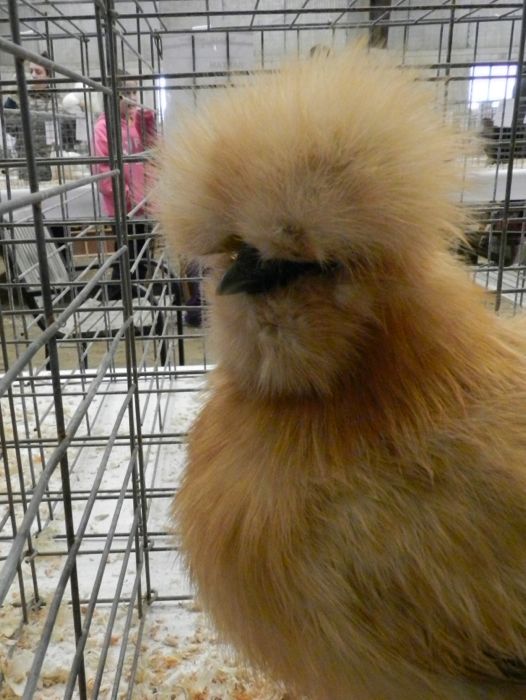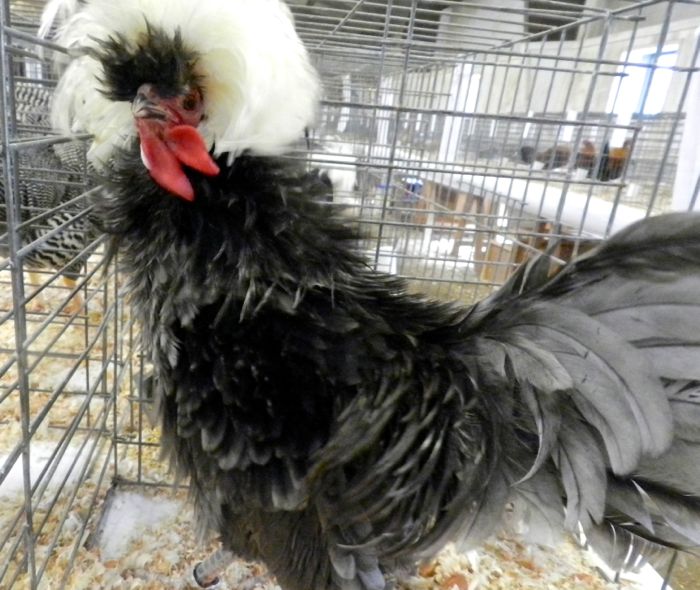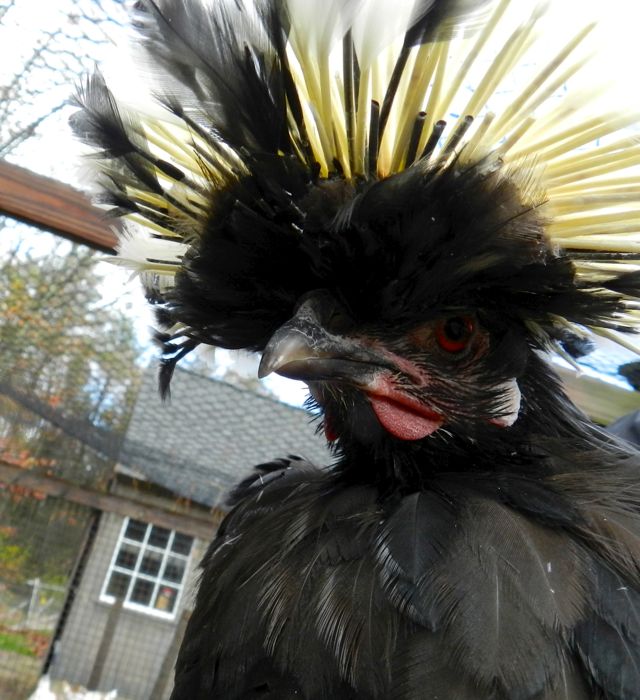Most chickens, whether they’re fluffy-bottomed Orpingtons or sleek Welsummers, are winter hardy. As long as you give them shelter out of the wind, a draft-free coop at night, and a constant supply of fresh water, they can ride out snowstorms, deep-freezes and whatever else winter throws their way.
Although you might think that you’re being kind and indulgent by hanging a heat lamp, you’re actually doing your hens a disservice. Chickens stay warm by fluffing up and trapping air between their feathers. They’re essentially wearing insulated down coats. When they stand under a heat lamp they stop fluffing. Do you know how nice it is on a cold winter day to warm up by a fire? Now think about how hard it is to move away from the hearth and how chilled you feel when you do. A chicken goes through exactly the same thing when stepping away from a heat lamp. She won’t want to. So she’ll stay still and won’t eat or drink or get the exercise that she needs. When she does move out from under the lamp, she won’t be fluffed up and so she won’t be warm. It’s better for a hen to keep herself cozy in her coat than to go from under a lamp to the cold outside of it’s warm glow.
However, a few types of chickens have unusual feathers and so do require extra winter care. Years ago I had a sweet little Silkie hen. She died one winter and I’d always assumed it was because I didn’t provide her with heat. There were experienced breeders of Silkies at the poultry show this past weekend I made a point of talking to several. I found out that I was wrong about the heat, but not wrong that Silkies require special winter care.
Despite feathers that look like fur,
and twisted feathers like those on this Bantam Frizzle Polish,
these birds don’t need heat. In fact, the breeders that I talked to had the same objections to heat lamps that I do. What these fancy chickens do need is to stay dry. Water rolls off of regular feathers. The outer “hard” feathers on most chickens repel water like a rain slicker. But Silkies have no protection against the damp. In the rain they become soggy sponges. Just standing in mud can kill them. Frizzles, too, can’t handle rain, as it drips between their feathers and soaks their skin. Polish, with their huge top-knots end up with sodden heads. Combine wet hens with cold temperatures, and you end up with sick chickens and death. The breeders of the fancy birds that I talked with said that they keep their stock indoors during the winter. They only allow them outside when the ground is dry and the sky is clear. Wind is also a concern. Without sturdy outer feathers to block cold gusts, these fancy chickens get chilled to the bone. Outside areas require wind breaks (a wall of straw bales works fine.)
All of these very experienced chicken keepers talked about how important clean, dry and well-ventilated coops are. Damp air must have a way up and out. Novices make the mistake of battening down their coops so tightly that there is no air flow. Manure is 75% water, and without good ventilation that water, and the ammonia from the breakdown of nitrogen in the manure, will cause respiratory disease. This is why I keep the coop clean. It’s why I installed a cupola in the roof of the little barn a couple of years ago. What a difference that made! No longer do the insides of the windows ice up.
I don’t keep Silkies because I don’t have a separate area for housing them indoors during the winter. I do have Polish. They’re not show birds and so I give them a winter haircut. Tina and Siouxsie got theirs the other day. They’re still growing in new feathers, so they look rather silly. But their heads are dry and they can see where they’re going. We’re ready for winter. For more about winter care and feeding of chickens, read my FAQ.




Looks like i’ll be preparing a seperate area for my silkies to stay inside the garage this winter (we don’t park in it), though my older silkies are smart enough to stay out of the weather, the 2 I bought this year, dont seem quite as smart.
It’s true that some are brighter than others :)
Terry~ are rabbits treated the same for winter? This is my first winter with 2 Palomino rabbits. They have freedom like Candy and have access to their hutch at all times. We close them up at night and open them in the morning. I have a heated water bottle and put straw around the hutch for extra warmth, is that all I need to do for them? I imagine they will love the Michigan snow this winter?!
This is my first winter and im a wreck, just worried that they will be ok. They only have a hutch right now but we are fixing the shed so they will have cover. It got pretty cold last night but they were all fine, except for frozen water. So I was a bit late to work getting them fresh water. Thats ok, they come first. What did I get myself into getting chickens. Lol, but not sorry love them to pieces!
They’ll be fine! Keep them dry and out of the wind. Water will freeze overnight, but no worries – they don’t drink at night. As long as it is replaced with a fresh fount in the morning, they’ll be okay.
Shannon- Rabbits actually do better in cold then heat. If you make sure their hutch is draft free and fill it with extra hay that they can burrow in they should be fine.
That’s right! Candy loves to sit on top of snow piles, and she burrows tunnels, too. I do make a point of changing her hay if it gets even a tad damp. And when there’s a nor-easter, we cover the hutch with a tarp so that the snow doesn’t blow in. Also, in the winter, we screw wooden sides onto the hutch so it is only open in the front. Because she’s outside all year, she’s tuned into the seasonal changes. She started laying on her winter fat and growing her fur coat last month.
We got our very first Silkie this spring. I’ve been worried about her in terms of the winter. If I’m understanding this correctly, my Silkie should be okay in our barn as long as she doesn’t go outside and/or is kept dry. We’ve converted an old cattle barn into a chicken coop of sorts. It’s well ventilated, and we line the walls with hay bales to provide a little bit of insulation. I’m hoping she’ll be okay out there this winter. Or should I bring her into our garage? Ugh…
Your set-up is exactly like one of the breeders described. I’m sure the barn is better than a concrete garage. Does she have a friend? She should be with other chickens. Time to buy another Silkie :)
Yes, she has a four friends, but they are not silkies! She’s currently in a stall with a Cochin Bantam and three Easter Eggers. Except for the feisty bantam, they are all very timid! However, they all get along very well and are my favorite birds! The rest of our flock is okay, but those are my husband’s! =) Will she be okay with these girls or does she need a silkie buddy for the winter? I’d rather wait until the spring to get another silkie, but I’ll do what is best for them! Thanks!
As long as she has friends, she’s fine. I wouldn’t introduce another chicken to this happy flock.
Hi Terry, what a great blog. Thanks for the cold weather tips. It’s my first year keeping chickens and these tips are great. I didn’t know about them “fluffing” their feathers to keep warm. They are smarter then I give them credit for. :)
Hi Terry,
My chickens are still young about 9 weeks .Im still using the 250 w red lamp continuously even now that they
are in their outdoor coop which has an enclosed run .They just recently started going outdoors on their own in the morning without being shooed out the door .(We installed an automatic door on a timer )
Should I discontinue using the lamp now before it gets too cold?
Should I wean them off gradually ?
thanks so much
liz
They need that lamp until they are fully feathered. Baby feathers won’t keep them warm enough. You should notice a change in behavior when they are comfortable in cold weather. If they don’t congregate directly under the heat lamp, then you know it’s giving off too much heat and you can raise it up.
I have used a low wattage heat bulb in my coop the last couple years for the sole purpose of keeping the hens water from freezing. Could you advise what you do in the winter to keep your inside water from freezing if not for the heat lamps? I, too don’t think its necessary for the chickens; after all sparrows and other wild birds are built the same as chickens and they don’t have the advantage of heat lamps and appear to survive fine through the toughest of winters; just not sure how else to keep the water from freezing. Thanks!
P.S. – would have loved to have been at that Boston poultry show!!
I use the galvanized heated waterer base made for poultry barns. You’ll see a photo of it on the winter care FAQ. I do cover the cord with a conduit, though, to protect it from mice and from Candy’s chewing.
Awesome! Thanks for the info!
Great picture of Tina/Siouxsie! Looks like they are ready to punk out with their spiky “hair”. :-)
Were the show Polish as ditzy and airheaded as your two ? Acourse maybe as they have aged, they might not be as flighty as they were. And seeing after a hair cut probably makes them more friendly to you. With your older hens passing away, I guess one of the Polish will soon be the boss of that coop. Though I have a feeling they will get along well with Pearl, the other Gems though probably not.
All of that breed are ditzy.
I tuned in this morning to see Candy in the girls’ dusting box inside. Does she do this regularly? I thought the cold didn’t bother her. Anyway, my day started with a laugh.
Candy likes the feel of the sand, and I think it keeps her clean, too. But, sometimes I think that she sits in there just to keep the hens out.
:-)
Isn’t that just like her. Gotta love it.
We have a heat lamp in the coop that comes on only when it dips down below freezing. They are happy to sit under it at night but come running out as soon as we open the coop door, and spend their days outside even in frigid or rainy weather. It just gives me piece of mind knowing there’s some kind of warmth on those exceptionally cold New England winter nights. Brr. We almost got a couple of silkies when we ordered our chicks. I’m glad we didn’t. They are sweet but such high maintenance. I love that last picture of Tina. She looks so happy to see the world!
LOL. I see Candy is back in the dusting box. That must be her Nor’easter shelter.
Heated base for water plugged and ready to go.
Plugged IN rather
I see snow!
(Not saying this is “news to you!”)
Oh-my-goodness!
Must peek in the barn… half expecting to see wool scarves and leg warmers!
my neighbor does two things that im not sure are really that good of a practice.
1) in using a heat lamp she aims it ‘at’ the chickens (eye level/horizon) instead of overhead. they are teens and are up on the pole roosting.
2) at night, the chickens stay on the ground waiting for the ‘scratch/treat she gives them each night, instead of getting up off the ground and roosting. its seem that it would be better to have them do their natural instinct. we do have predators, but she does this around dusk, and doesnt wait until dark.
I have my own chickens for 6yrs.
can you email me directly?
I’ll answer the questions here, as they’re good ones. If the pullets are feathered out, then they don’t need heat. If you do insist on giving heat, then it’s best to have it hanging, so that the chickens can move under and away at will. This way they can control their body temperature (just as a warning – chicks can die from being too hot. Always have a cooler area that they can move into.) Feeding right before bedtime is an old farmer’s trick. It’s good for egg laying for the chickens to go to bed with their crops full. But, it should be done before the hens go to roost. Once chickens go to bed, they should be left alone.That said, she might have reasons for doing what she’s doing. Each set-up is unique.